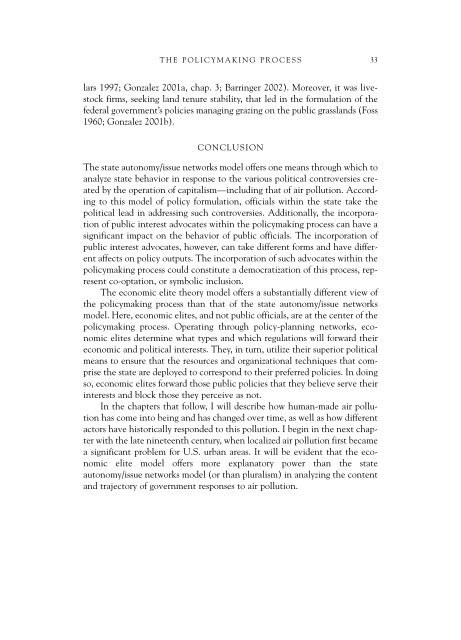GEORGE A. GONZALEZ - fieldi
GEORGE A. GONZALEZ - fieldi
GEORGE A. GONZALEZ - fieldi
You also want an ePaper? Increase the reach of your titles
YUMPU automatically turns print PDFs into web optimized ePapers that Google loves.
THE POLICYMAKING PROCESS 33lars 1997; Gonzalez 2001a, chap. 3; Barringer 2002). Moreover, it was livestockfirms, seeking land tenure stability, that led in the formulation of thefederal government’s policies managing grazing on the public grasslands (Foss1960; Gonzalez 2001b).CONCLUSIONThe state autonomy/issue networks model offers one means through which toanalyze state behavior in response to the various political controversies createdby the operation of capitalism—including that of air pollution. Accordingto this model of policy formulation, officials within the state take thepolitical lead in addressing such controversies. Additionally, the incorporationof public interest advocates within the policymaking process can have asignificant impact on the behavior of public officials. The incorporation ofpublic interest advocates, however, can take different forms and have differentaffects on policy outputs. The incorporation of such advocates within thepolicymaking process could constitute a democratization of this process, representco-optation, or symbolic inclusion.The economic elite theory model offers a substantially different view ofthe policymaking process than that of the state autonomy/issue networksmodel. Here, economic elites, and not public officials, are at the center of thepolicymaking process. Operating through policy-planning networks, economicelites determine what types and which regulations will forward theireconomic and political interests. They, in turn, utilize their superior politicalmeans to ensure that the resources and organizational techniques that comprisethe state are deployed to correspond to their preferred policies. In doingso, economic elites forward those public policies that they believe serve theirinterests and block those they perceive as not.In the chapters that follow, I will describe how human-made air pollutionhas come into being and has changed over time, as well as how differentactors have historically responded to this pollution. I begin in the next chapterwith the late nineteenth century, when localized air pollution first becamea significant problem for U.S. urban areas. It will be evident that the economicelite model offers more explanatory power than the stateautonomy/issue networks model (or than pluralism) in analyzing the contentand trajectory of government responses to air pollution.









